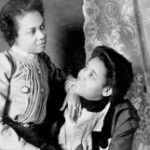Thomas E. Askew (1848? – 1914)
Atlanta’s first African American photographer. Began his photography career in the 1880s at Motes Studio downtown Atlanta. Later operated his own studio from home on Summit Avenue. Three years after his death, the Great Fire of 1917 destroyed all of his photographic equipment and negatives.
“African American History Tour Script,” Oakland Cemetery, Atlanta, GA
From the vantage point of the 21st century, the life and career of photographer Thomas E. Askew seems to be a tenuous footnote in history, nearly obliterated by the fire which consumed his studio after his death. His existing photographs, held in private collections in Atlanta, reveal a mastery of lighting and composition.i Using the markers of Askew’s signature lace curtain and tapestry, historian Shawn Michelle Smith has demonstratedii that Thomas E. Askew produced many of the studio portraits for the albums included in W.E.B. DuBois’ Georgia Negro Exhibit, which premiered at the 1900 Paris Exhibition.
The Georgia Negro Exhibit marked a major turning point in the use of photography by African Americans to articulate a self-defined image of Who We Are. Its ostensible purpose was to present the progress of African Americans from the end of slavery to the dawn of the new century. But in the portraits prepared by Askew, the Georgia Negro Exhibit provided a resounding declaration of the self-worth, self-esteem and self determination of a people in spite of the obstacles thrown in their path. It was at the Paris Exhibition, by far the largest international exhibition of its time, attracting nearly 50 million visitors, in a caption for one of the displays, that DuBois declared: “The problem of the twentieth century is the problem of the color line.”
Askew’s portraits of men tend to be rather closely cropped, offering a study of their faces, sculpted and highlighted by side illumination, representing the story of their lives. The men thus depicted as sufficient unto themselves, men to be admired, emulated and revered.iii In contrast to his portraits of men, Askew’s portraits of women generally include more of the body and studio surroundings, the setting resembling a parlor or a sitting room, thus associating women more directly with the comforts of home, their identities rooted in an interior, domestic space. While Askew does not show the hands of his male subjects, in his portraits of women, the wedding ring seems to function as a symbol of women’s respectability.iv
Thomas Askew made some remarkably beautiful photographs of young children. He must have been especially adept at putting them at ease, for these young girls and boys appear perfectly at home in their little bodies, without the awkward gangliness of youth; their expressions are soft and composed. Askew positions his child models between two small sculptures which show up again and again in his portraits of children, one a warrior of ancient nobility and the other of an unkempt Huck Finn-like childishness. If the figures suggest the paths that might define the future of Askew’s subjects, the impeccable grooming, crisp, clean, stylish clothes, and composed faces of these African American children clearly distinguish them from the sloppy boy figure and align them with the classical ideals of the warrior.v
As he inscribes African American children into an ennobling narrative, Thomas Askew also inscribes himself into a genealogy that reaches back to a classical age, claiming a space for himself, for his African American subjects, and for photography in the realms of the ideal, of the exalted, of (western) art. By marking his subjects and his very medium the stuff of art, Askew anchors photographic portraiture in the realm of subjectivity and identity.vi
In her essayvii about Black photographer Prentice H. Polk, who also worked in Atlanta and extensively at Tuskegee in the 1930s and 1940s, Pearl Cleage Lomax wrote:
He would take our pictures and let us see that those who said we were invisible were lying. That those who said we were ugly were lying. That those who claimed we were less than human were lying. That those who said we did not love each other, and marry, and produce children, and suffer, and grow old were lying…[He] would let us bloom in the safe zone before his camera, and we saw ourselves differently through his lenses. We saw ourselves shining in all our specificity. In all our generalities. In all our terrible humanness. We saw ourselves just shine.
The same could certainly be said about the work of Thomas E. Askew and his singular contribution to the Georgia Negro Exhibition. He made us just shine.
i Reflections in Black, by Deborah Willis, p.14
ii Photography on the Color Line: WEB DuBois, Race and Visual Culture, by Shawn Michelle Smith, (Duke University Press: 2004) p.4
iii Ibid, p.69
iv Ibid, p.70ff
v Ibid, p.72
vi Ibid, p.75
vii “Take My Picture, Mr. Polk,” Pearl Cleage Lomax, in P.H. Polk: Photographs (Atlanta: Nexus, 1980) p. 107


Thank you for this wonderful and informative essay. I had never heard of this gifted man before reading it. God bless you for posting it for all to read and see some of his works.